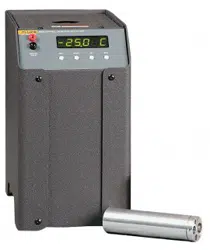Loading ...
Loading ...
Loading ...

10 Calibration Procedure
Sometimes the user may want to calibrate the instrument to improve the tem
-
perature set-point accuracy. Calibration is done by adjusting the controller
probe calibration constants R0, ALPHA, DELTA, and BETA so that the tem
-
perature of the calibrator as measured with a standard thermometer agrees more
closely with the set-point. The thermometer used must be able to measure the
well temperature with higher accuracy than the desired accuracy of the calibra
-
tor. By using a good thermometer and following this procedure the instrument
can be calibrated to an accuracy of better than 0.5°C up to 140°C.
10.1 Calibration Points
In calibrating the instrument, R0, ALPHA, DELTA, and BETA, are adjusted to
minimize the set-point error at each of three different temperatures. Any three
reasonably separated temperatures may be used for the calibration. Improved
results can be obtained for shorter ranges when using temperatures that are just
within the most useful operating range of the instrument. The farther apart the
calibration temperatures, the larger will be the calibrated temperature range but
the calibration error will also be greater over the range. If, for instance, –20°C
to 100°C is chosen as the calibration range, the calibrator may achieve an accu-
racy of say ±0.3°C over the range –20 to 100°C. Choosing a range of 50°C to
90°C may allow the calibrator to have a better accuracy of maybe ±0.2°C over
that range but outside that range the accuracy may be only ±1.5°C.
10.2 Calibration Procedure
1. Choose four set-points to use in the calibration of the R0, ALPHA,
DELTA, and BETA parameters. These set-points are generally –25°C,
0°C, 60°C, and 125°C but other set-points may be used if desired or
necessary.
2. Set the instrument to the low set-point. When the instrument reaches the
set-point and the display is stable, wait 15 minutes or so and then take a
reading. Sample the set-point resistance by holding down the “SET” key
and pressing the “DOWN” key. Write these values down as T
1
and R
1
respectively.
3. Repeat step 2 for the other three set-points recording them as T
1
, R
1
, T
2
,
R
2
, T
3
, R
3
, T
4
and R
4
respectively.
4. Using the recorded data, calculate new values for R0, ALPHA, DELTA,
and BETA parameters using the equations given below.
10.2.1 Compute DELTA
AT T=−
43
39
10 Calibration Procedure
Calibration Points
1.888.610.7664 sales@GlobalTestSupply.com
Fluke-Direct.com
Loading ...
Loading ...
Loading ...
